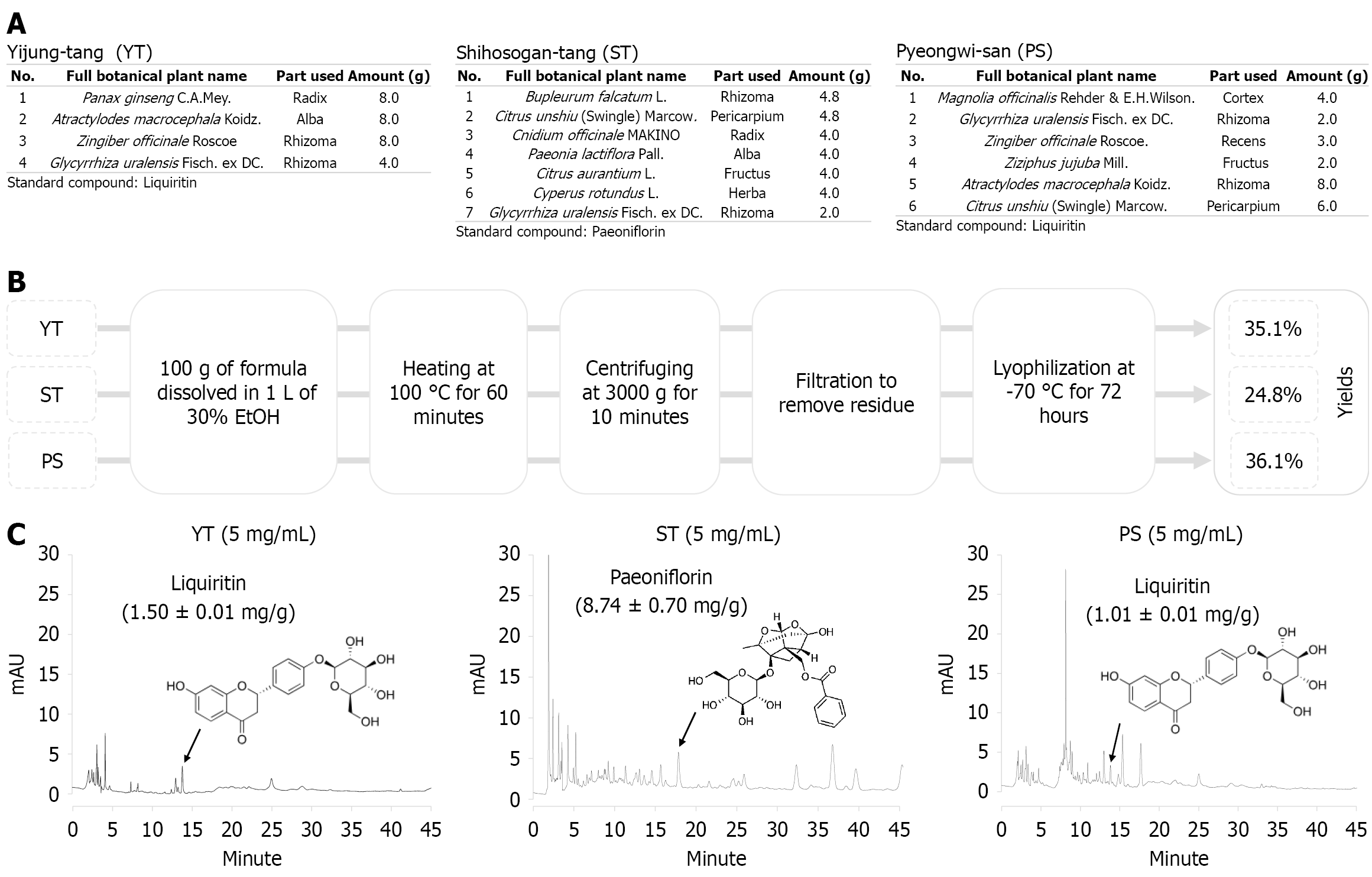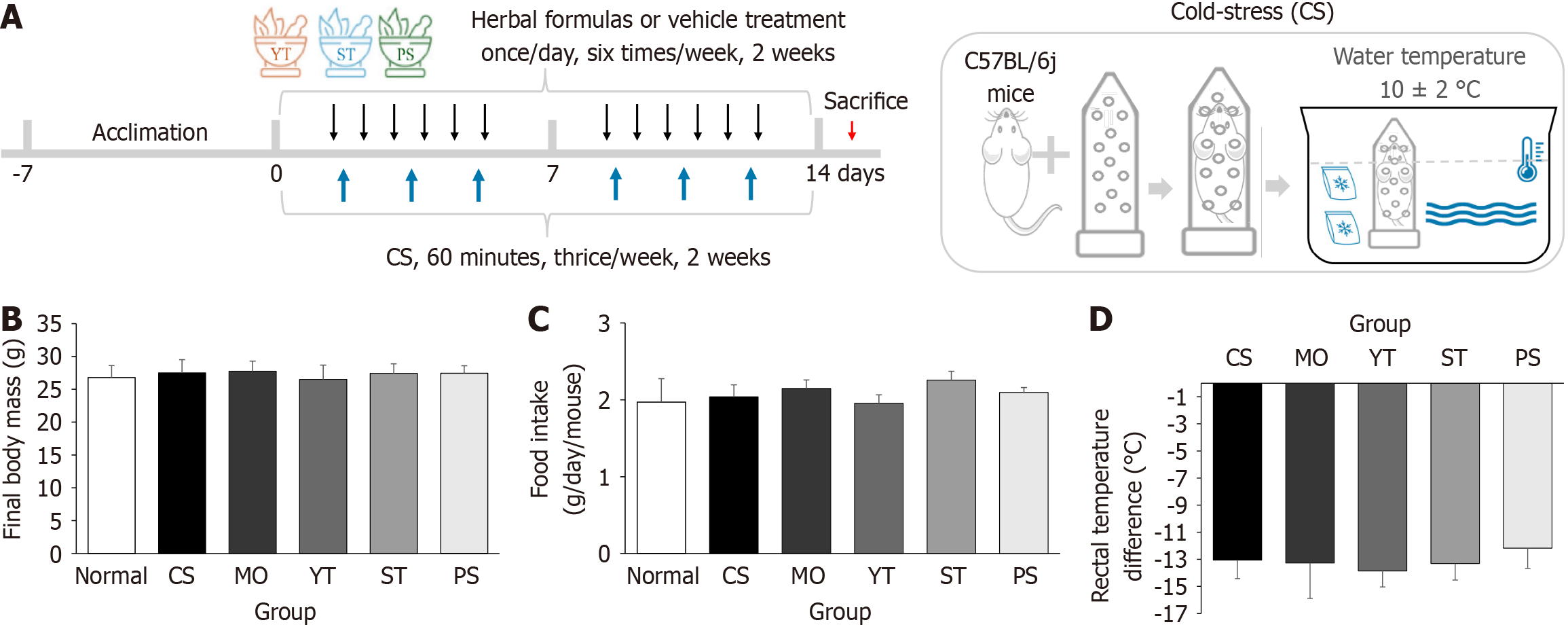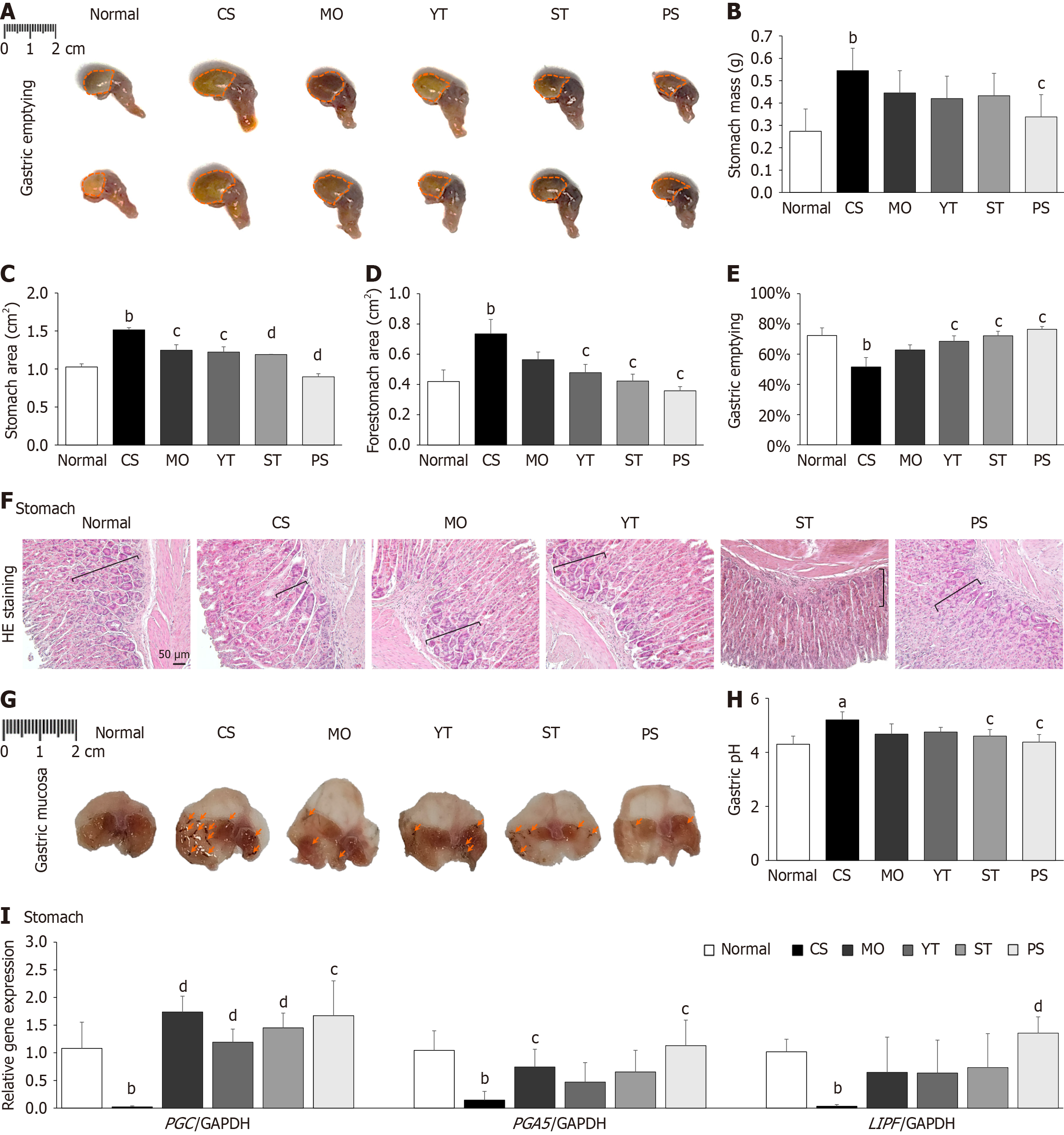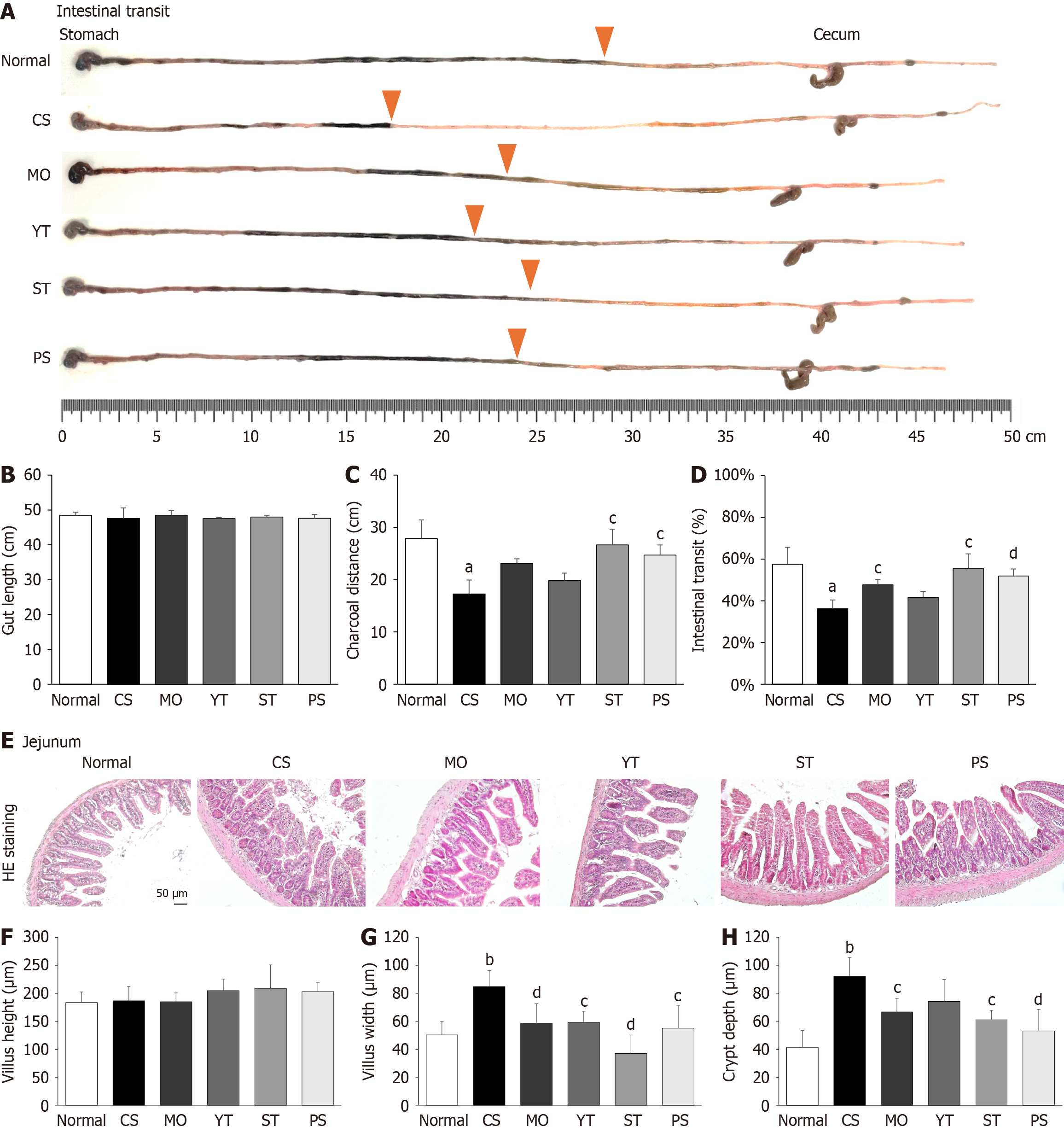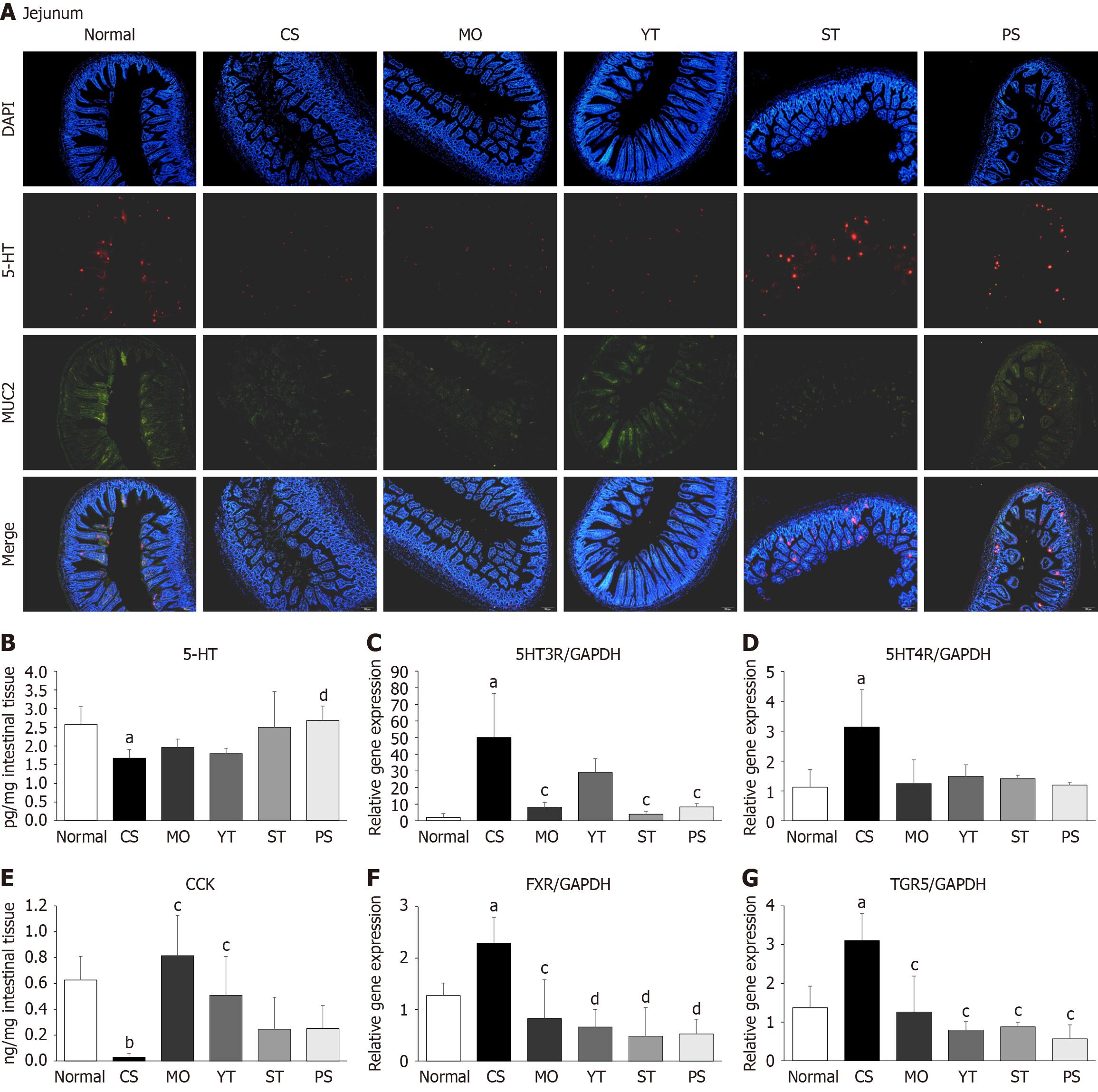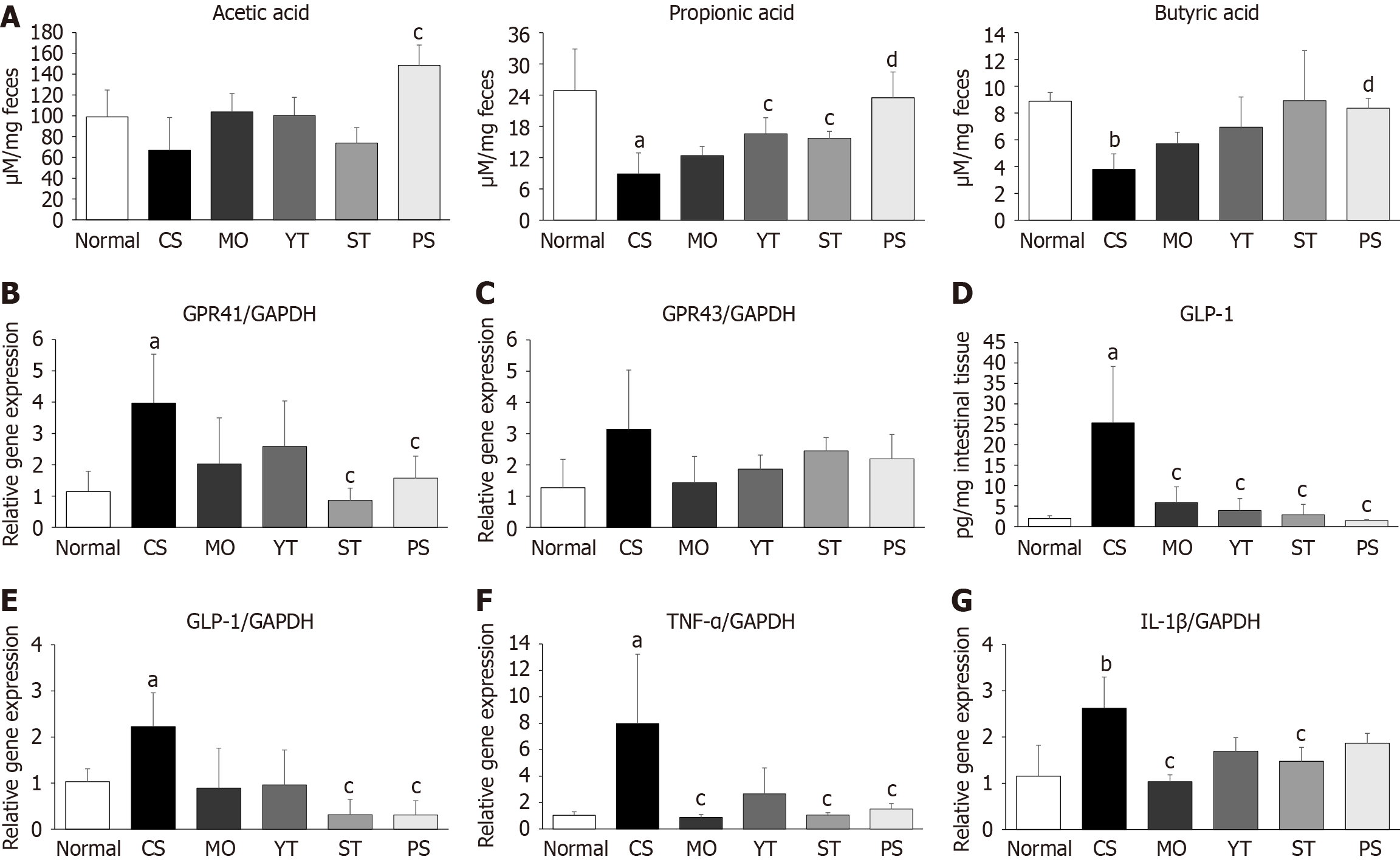Copyright
©The Author(s) 2025.
World J Gastroenterol. Sep 21, 2025; 31(35): 109808
Published online Sep 21, 2025. doi: 10.3748/wjg.v31.i35.109808
Published online Sep 21, 2025. doi: 10.3748/wjg.v31.i35.109808
Figure 1 Components of herbal formulas, extraction procedure, and high-performance liquid chromatography fingerprinting.
A: Compo
Figure 2 Experimental schedule and basic characteristics of mice.
A: Experimental schedule and schematic of the cold stress model; B: Comparison of mean bodyweight on the final experimental day (n = 12/group); C: Comparison of average daily food intake; D: The difference in rectal temperature between the start and 30 minutes after cold stress (n = 8 or 12). YT: Yijung-tang; ST: Shihosogan-tang; PS: Pyeongwi-san; CS: Cold stress; MO: Mosapride.
Figure 3 Gastric emptying activity of herbal formulas under cold stress.
A: Morphology of the stomach after phenol red intragastric administration; B: Stomach weight; C: Stomach area; D: Forestomach area; E: Gastric emptying rate were compared; F: Paraffin-embedded stomach tissue stained with hematoxylin-eosin; G: Morphology of the gastric mucosa and hemorrhagic lesions (indicated by orange arrows); H: Comparison of gastric potential of hydrogen; I: Comparison of gene expression levels of gastric digestive enzymes. aP < 0.05, compared with the normal group; bP < 0.01, compared with the normal group; cP < 0.05, compared with the normal group; dP < 0.01, compared with the cold stress group (n = 4 or 8). YT: Yijung-tang; ST: Shihosogan-tang; PS: Pyeongwi-san; CS: Cold stress; MO: Mosapride; GAPDH: Glyceraldehyde 3-phosphate dehydrogenase; HE: Hematoxylin-eosin; pH: Potential of hydrogen.
Figure 4 Intestinal transit activity of herbal formulas under cold stress.
A: Morphology of the stomach and intestine after intragastric administration of charcoal; B: Gut length; C: Charcoal transit distance; D: Intestinal transit rate was compared; E: Paraffin-embedded jejunum tissue stained with hematoxylin-eosin; F-H: Villus height (F), villus width (G), and crypt depth (H) were compared. aP < 0.05, compared with the normal group; bP < 0.01, compared with the normal group; cP < 0.05, compared with the normal group; dP < 0.01, compared with the cold stress group (n = 4 or 8). YT: Yijung-tang; ST: Shihosogan-tang; PS: Pyeongwi-san; CS: Cold stress; MO: Mosapride.
Figure 5 Changes in intestinal serotonin, cholecystokinin, and bile acid receptors.
A: Immunofluorescence staining of the jejunum for 5-hydroxytryptamine (5-HT) and MUC2; B: Comparison of 5-HT concentration in intestinal tissue; C and D: Comparison of gene expression levels of 5-HT receptors; E: Comparison of cholecystokinin concentration in intestinal tissue; F and G: Comparison of gene expression levels of bile acid receptors. aP < 0.05, compared with the normal group; bP < 0.01, compared with the normal group; cP < 0.05, compared with the normal group; dP < 0.01, compared with the cold stress group (n = 4 or 8). YT: Yijung-tang; ST: Shihosogan-tang; PS: Pyeongwi-san; CS: Cold stress; MO: Mosapride; 5-HT: 5-hydroxytryptamine; DAPI: 4’,6-diamidino-2-phenylindole; 5HT3R: 5-hydroxytryptamine type 3 receptor; 5HT4R: 5-hydroxytryptamine type 4 receptor; CCK: Cholecystokinin; FXR: Farnesoid X receptor; TGR5: Takeda G-protein-coupled receptor 5; GAPDH: Glyceraldehyde 3-phosphate dehydrogenase.
Figure 6 Alterations in short-chain fatty acids, and related mechanisms.
A: Fecal levels of short-chain fatty acids (SCFAs), including acetic acid, propionic acid, and butyric acid, were measured by high-performance liquid chromatography; B and C: Messenger RNA (mRNA) expression of SCFA receptors G protein-coupled receptor 41 (B) and G protein-coupled receptor 43 (C) was determined by quantitative polymerase chain reaction; D and E: Intestinal glucagon-like peptide-1 (GLP-1) levels (D), GLP-1 mRNA expression (E) were compared among groups; F and G: Gene expression of inflammatory cytokines tumor necrosis factor-α (F) and interleukin-1β (G) was assessed. aP < 0.05, compared with the normal group; bP < 0.01, compared with the normal group; cP < 0.05, compared with the normal group; dP < 0.01, compared with the cold stress group (n = 4 or 8). YT: Yijung-tang; ST: Shihosogan-tang; PS: Pyeongwi-san; CS: Cold stress; MO: Mosapride; GAPDH: Glyceraldehyde 3-phosphate dehydrogenase; GPR41: G protein-coupled receptor 41; GPR43: G protein-coupled receptor 43; GLP-1: Glucagon-like peptide-1; TNF-α: Tumor necrosis factor-alpha; IL-1β: Interleukin-1 beta.
- Citation: Wang JH, Han SY, Wu L, Han U, Cho SK, Park CW, Chin YW, Lim MY, Kim H. Comparative evaluation of three traditional herbal formulas on gastrointestinal motility in a mouse model of cold stress-induced dyspepsia. World J Gastroenterol 2025; 31(35): 109808
- URL: https://www.wjgnet.com/1007-9327/full/v31/i35/109808.htm
- DOI: https://dx.doi.org/10.3748/wjg.v31.i35.109808













